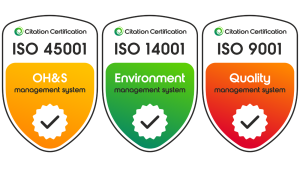Working at Heights
Working at heights is a common hazard that can be found in most industries and workplaces. Falling from a height is one the leading causes of fatalities and serious injuries. In New South Wales between 2014 and 2017 over 12,000 workers were injured because of falling from heights. Over 240 people sustained injuries resulting in permanent disability and 25 people died.
Some common causes of falls:

Prior to commencing work, conduct a risk assessment to identify any hazards and how they can be controlled. It is important to consult with workers during this phase as they can provide insight based on their knowledge and experience from performing the work.
Control the risk
The most effective way to control the risk is by eliminating the need to work at height. This can be don’t by performing the work from the ground, by building a solid work platform with guard rails, or covering penetrations.
If working at height cannot be avoided, you must then find a way to control the risk. Fall prevention devices are used to stop a person from falling while working at height. Fall prevention devices can include scaffold systems, Elevating Work Platforms (EWP), mast climbing work platforms, and perimeter guardrails.
Work positioning systems should only be considered when working from the ground or fall prevention devices are not practical. Work positioning systems require the user to be trained and highly competent in the setup and use of these systems. Examples include a harness connected to an anchor point or lifeline via a lanyard, and rope access systems.
Fall arrest systems stop a person after the fall and are designed to safely stop the worker falling or reduce the severity of injuries from a fall. These systems must only be used where higher-level controls are not reasonably practicable or where higher-level controls are considered not fully effective on their own, such as working in an EWP.
Planning for emergencies
Working at heights can sometimes present some unique challenges in an emergency. Your emergency response procedures will need to address hazards that can affect emergencies. Consider how will a person be rescued from the top of a formwork deck, alternative evacuation routes where a person hoist is used, or how will a worker be rescued from their harness when using a fall arrest system.
MORE INFORMATION:
More information on managing the risks of falls in the workplace can found in the SafeWork NSW Code of Practice – Managing the Risk of Falls at Workplaces.
Download the full article here: Working at heights by Allan Dostal 2021
You can also down load our Fall Prevention poster here: RI-DDK-0204-003-Fall-Prevention-Poster-w-Tresle-Ladders-Rev-1 (1)
NSW Planning to prevent falls – formwork video attached:

